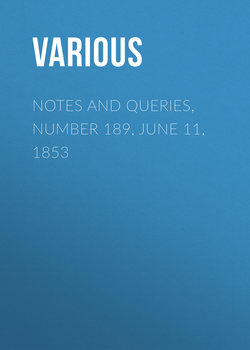Читать книгу Notes and Queries, Number 189, June 11, 1853 - Various - Страница 8
Minor Queries
ОглавлениеThirteen an unlucky Number.—Is there not at Dantzic a clock, which at 12 admits, through a door, Christ and the Eleven, shutting out Judas, who is admitted at 1?
A. C.
Quotations.—
"I saw a man, who saw a man, who said he saw the king."
Whence?
"Look not mournfully into the past; it comes not back again," &c.—Motto of Hyperion.
Whence?
A. A. D.
"Other-some" and "Unneath."—I do not recollect having ever seen these expressions, until reading Parnell's Fairy Tale. They occur in the following stanzas:
"But now, to please the fairy king,
Full every deal they laugh and sing,
And antic feats devise;
Some wind and tumble like an ape,
And other-some transmute their shape
In Edwin's wondering eyes.
"Till one at last, that Robin hight,
Renown'd for pinching maids by night,
Has bent him up aloof;
And full against the beam he flung,
Where by the back the youth he hung
To sprawl unneath the roof."
As the author professes the poem to be "in the ancient English style," are these words veritable ancient English? If so, some correspondent of "N. & Q." may perhaps be able to give instances of their recurrence.
Robert Wright.
Newx, &c.—Can any of your readers give me the unde derivatur of the word newx, or noux, or knoux? It is a very old word, used for the last hundred years, as fag is at our public schools, for a young cadet at the Royal Military Academy, Woolwich. When I was there, some twenty-five or twenty-seven years ago, the noux was the youngest cadet of the four who slept in one room: and a precious life of it he led. But this, I hope, is altered now. I have often wanted to find out from whence this term is derived, and I suppose that your paper will find some among your numerous correspondents who will be able to enlighten me.
T. W. N.
Malta.
"A Joabi Alloquio."—Who can explain the following, and point out its source? I copy from the work of a Lutheran divine, Conrad Dieteric, Analysis Evangeliorum, 1631, p. 188.:
"A Joabi Alloquio,
A Thyestis Convivio,
Ab Iscariotis 'Ave,'
A Diasii 'Salve'
Ab Herodis 'Redite'
A Gallorum 'Venite.'
Libera nos Domine."
The fourth and sixth line I do not understand.
B. H. C.
Illuminations.—When were illuminations in cities first introduced? Is there any allusion to them in classic authors?
Cape.
Heraldic Queries.—Will some correspondent versed in heraldry answer me the following questions?
1. What is the origin and meaning of women of all ranks, except the sovereign, being now debarred from bearing their arms in shields, and having to bear them in lozenges? Formerly, all ladies of rank bore shields upon their seals, e.g. the seal of Margaret, Countess of Norfolk, who deceased A.D. 1399; and of Margaret, Countess of Richmond, and mother of Henry VIII., who deceased A.D. 1509. These shields are figured in the Glossary of Heraldry, pp. 285, 286.
2. Is it, heraldically speaking, wrong to inscribe the motto upon a circle (not a garter) or ribbon round the shield? So says the Glossary, p. 227. If wrong, on what principle?
3. Was it ever the custom in this country, as on the Continent to this day, for ecclesiastics to bear their arms in a circular or oval panel?—the martial form of the shield being considered inconsistent with their spiritual character. If so, when did the custom commence, and where may instances be seen either on monuments or in illustrated works?
